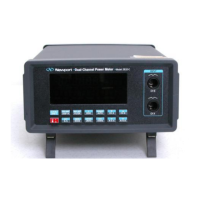3.6.3 Ambient
and
Stray
Light
Ambient and stray light striking the detector should be considered when
making a measurement. Ambient light can be distinguished from dark current
(or the detector/meter noise floor) by either turning
off
or blocking the source
and covering the detector face with opaque material such
as
a piece
of
black
rubber.
Using the human hand to cover the detector is not advised because it emits a
significant amount
of
infrared radiation and radiates a temperature signifi-
cantly different from ambient. With the detector covered, a reading of the
dark current may be made. Next, remove the material which
is
covering the
detector and take another reading. The difference is the ambient light level.
NOTE
Changes in ambient light levels can occur from such factors
as
turning room
lights on or
off,
or by moving people or equipment. Remember, if you can
see
your detector element, then your detector can
see
the light bouncing
off
you.
The effects
of
ambient light are greatly reduced when using a fiberconnectorized
signal input to the detector.
If
free-space beam measurements are desired,
using an attenuator will often improve the signal to ambient signal noise level.
Wavelength-specific filters, such as optical cutoff, bandpass, or spike filters
can be used
if
the signal wavelength spectrum permits. Other techniques to
reduce stray light include using apertures, placing the detector in a box or
other housing to shield the surface from light (or air currents) and turning
off
room and other polluting light sources.
3.6.4 Common Measurement
Errors
The most common sources of optical measurement error are listed in Table
19
below. Other common errors are discussed in the preceding subsections
of
Section
3.10,
Measurement Considerations.
Table
19
-
Common Measurement
Errors
Type of Error
What should be done?
Radiometry
Check that all
of
the light
is
actually hitting
the detector.
Ambient Light
Check that any ambient light was ZEROed
before the measurement was made.
Wavelength Calibration
Check that the Calibration Factor for the
measurement wavelength is properly set.
Detector Saturation Check that the optical power density remains
or Damage
below the detector's saturation or damage
threshold.
NOTE
The Model
28324
will indicate when a detector is being operated above its
saturation or damage threshold by displaying "SA in the measurement
display area. Be aware that detectors often experience local saturation or
damage without ever exceeding an overall saturation or damage threshold.
This only applies to semiconductor photodiodes used above maximum
intermittent power.
Detector damage can still arise even when
"SAW
is
not displayed. Be sure to
follow your detector manual's user guidelines.
29
Artisan Technology Group - Quality Instrumentation ... Guaranteed | (888) 88-SOURCE | www.artisantg.com

